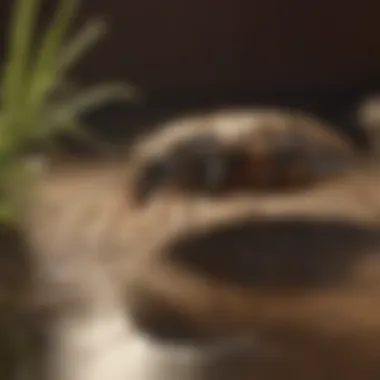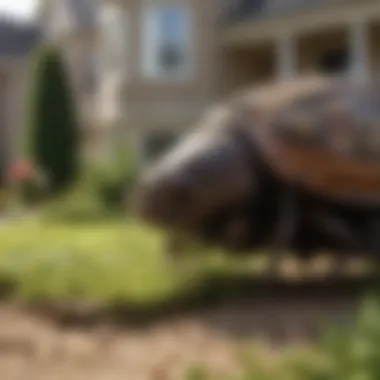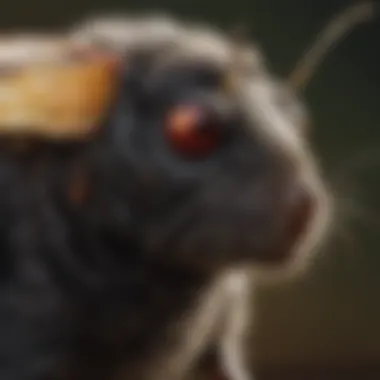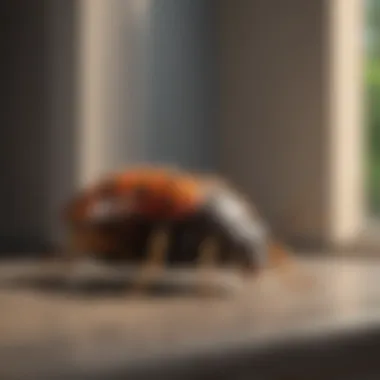Mastering Pest Control: Expert Strategies for Bug-Free Living Spaces


Preventive Pest Control Strategies
When it comes to keeping bugs at bay, preventive pest control strategies play a crucial role in maintaining a pest-free environment within your living spaces. One of the primary areas to focus on is securing your house's exterior. This involves diligently sealing cracks and crevices around windows, doors, and foundations to prevent unwelcome intruders. Additionally, clearing debris such as overgrown vegetation or leaf piles can help eliminate hiding spots for pests. By implementing these simple yet effective measures, you can significantly reduce the chances of pests finding their way into your home.
Yard maintenance is another key aspect of preventive pest control. By adhering to essential yard care routines such as mowing the lawn regularly and eliminating standing water sources, you create an environment that is less hospitable to pests. Furthermore, implementing methods like proper waste management and utilizing pest-resistant plants can further enhance your yard's pest-free status.
Maintaining indoor cleanliness is vital in deterring pests from taking up residence in your home. Expert cleaning tips and techniques, such as frequently vacuuming carpets and rugs, decluttering storage areas, and sealing food containers, can go a long way in preventing infestations. Creating a pest-resistant indoor environment involves addressing potential entry points for pests, such as gaps around pipes or vents, and ensuring they are properly sealed.
Efficient garbage disposal is a fundamental element of effective pest control. By using sealed trash bins, promptly disposing of food waste, and keeping outdoor areas clean and free of debris, you can significantly reduce the likelihood of attracting pests to your property. Proper garbage disposal not only helps in minimizing pest infestations but also contributes to overall hygiene and sanitation.
In addition to these core preventive measures, there are innovative ways to safeguard your home against pests. These may include installing screens on windows and doors, applying weather stripping to seal gaps, or utilizing ultrasonic pest repellents. By taking a proactive approach to pest control and integrating these preventive strategies into your routine, you can create a more pest-resistant environment for you and your family.
Understanding Common Household Pests
In this intricate exploration of effective strategies for pest control, understanding common household pests emerges as a pivotal cornerstone. By delving into the nuances of identifying and categorizing these invasive creatures, homeowners gain a crucial edge in preemptive pest management. This section serves as the foundational bedrock upon which the entire pest control regimen is built, offering a nuanced insight that is essential for combating infestations. Understanding common household pests not only aids in early detection but also facilitates tailored intervention strategies, leading to more efficient and sustainable pest control practices.
Identifying Pest Infestations
Signs of Common Household Pests
Signs of common household pests represent nature's early warning signals, alerting inhabitants to the presence of unwelcome visitors. From telltale droppings to erratic movements in the shadows, these signs serve as red flags that cannot be ignored. By deciphering and acknowledging these indicators, individuals can proactively address pest issues before they spiral out of control. The significance of recognizing signs of common household pests lies in its ability to prompt timely action, safeguarding homes from extensive damage and potential health hazards. By familiarizing oneself with the distinct signs associated with various pests, homeowners empower themselves to act decisively and decisively in the face of infestations.
Damage Caused by Pests
The aftermath of a pest invasion manifests in the form of destructive repercussions that can wreak havoc on household harmony. From gnawed wires to tattered fabrics, the damage caused by pests extends far beyond mere physical destruction. It infiltrates the psyche of occupants, instilling fear and a sense of violation within the comfort of one's abode. Understanding the extent of damage caused by pests serves as a wake-up call, prompting individuals to fortify their defenses against potential intruders. By comprehending the full spectrum of destruction that pests are capable of unleashing, homeowners are motivated to take preemptive measures, thus mitigating the risks posed by these insidious creatures.
Types of Household Pests
Cockroaches
Cockroaches, with their resilient nature and prolific breeding habits, pose a formidable challenge to households worldwide. Their adaptability to diverse environments and penchant for nocturnal activities make them a ubiquitous threat to cleanliness and hygiene. By shedding light on the elusive behaviors of cockroaches, individuals can formulate targeted strategies to thwart their advances effectively. The key characteristic of cockroaches lies in their rapid reproduction rate and nocturnal habits, rendering them elusive targets for eradication. Despite their persistent nature, understanding the unique features of cockroaches empowers homeowners to implement holistic pest control measures that address both current infestations and potential future incursions.
Ants


Ants, with their collective prowess and unwavering determination, exemplify the power of organized effort in pest proliferation. Their keen sense of scent and seamless communication enable them to traverse vast distances in search of sustenance, leaving behind intricate trails of foraging routes. The key characteristic of ants lies in their collaborative behavior and hierarchical structure, which confers them a competitive edge in the realm of pest survival. By delving into the intricate dynamics of ant colonies, individuals gain a deeper understanding of how to disrupt their organized networks and mitigate their impact on domestic environments.
Spiders
Spiders, with their arachnid allure and stealthy maneuvers, embody a unique facet of household pests that straddle the line between fear and fascination. Their silk-spinning abilities and predatory instincts make them both marvels of nature and harbingers of unease for many inhabitants. The key characteristic of spiders lies in their web-weaving prowess and predatory nature, which sets them apart as solitary hunters in the realm of household pests. By demystifying the behaviors and habitats of spiders, individuals can coexist peacefully with these arachnids while safeguarding their homes from potential infestations.
Rodents
Rodents, with their gnawing tendencies and rapid reproduction cycles, symbolize a persistent threat to the structural integrity of homes. Their ability to squeeze through the tiniest crevices and establish nests in secluded corners make them elusive adversaries in the battle against household pests. The key characteristic of rodents lies in their adaptability to diverse environments and scavenging instincts, which drive them to seek shelter and sustenance within human habitations. By understanding the unique features of rodents, individuals can institute robust pest control measures that address both the rodents' immediate presence and the underlying vulnerabilities that facilitate their entry.
Bedbugs
Bedbugs, with their nocturnal feeding habits and stealthy demeanor, epitomize the covert intrusion that challenges the sanctity of sleep and relaxation. Their cryptic behavior and physiological adaptations make them formidable foes in the realm of household pests, evading detection and breeding discreetly within bedding and furniture. The key characteristic of bedbugs lies in their affinity for human blood and crepuscular activities, which render them elusive targets for conventional pest control methods. By unraveling the unique features of bedbugs, individuals can preempt their incursions and safeguard their sleeping spaces from potential infestations.
Preventive Measures for Pest Control
In this comprehensive guide to keeping bugs at bay, preventive measures for pest control play a crucial role in maintaining a pest-free environment. By implementing proactive strategies, individuals can mitigate the risk of pest infestations and ensure a hygienic living space. Preventive measures encompass various elements, including cleanliness practices, sealing entry points, and outdoor maintenance.
Maintaining Cleanliness
Proper Food Storage
Proper food storage is a fundamental aspect of maintaining cleanliness and preventing pest infestations. By storing food items properly in airtight containers and refrigerators, individuals can deter pests attracted to food sources. The key characteristic of proper food storage lies in preserving the quality of food and minimizing odors that may attract pests. This practice is a popular choice for pest control as it effectively removes potential food sources for insects and rodents. The unique feature of proper food storage is its ability to prolong the shelf life of groceries while protecting them from pest contamination.
Regular Cleaning Practices
Regular cleaning practices are essential for upholding hygiene standards and deterring pests from infesting homes. By keeping living spaces clean and clutter-free, individuals eliminate hiding spots and breeding grounds for pests. The key characteristic of regular cleaning practices is the systematic approach to sanitizing surfaces, removing debris, and managing waste effectively. This practice is beneficial for pest control as it disrupts the pest's access to food and water sources, forcing them to seek alternative environments. The unique feature of regular cleaning practices is the promotion of a healthy living environment while reducing the risk of pest-related health hazards.
Sealing Entry Points
Cracks and Crevices
Addressing cracks and crevices in the home is critical for preventing pests from infiltrating the living space. By sealing off entry points with caulking or sealants, individuals create a barrier that restricts pest access. The key characteristic of addressing cracks and crevices is the attention to detail in identifying potential entry points and sealing them effectively. This practice is a popular choice for pest control as it fortifies the home's defenses against invasive pests. The unique feature of addressing cracks and crevices is its proactive approach in preventing infestations before they occur, thereby reducing the need for reactive pest management measures.
Window Screens


Installing window screens is a strategic measure to prevent flying insects and other pests from entering the home through open windows and doors. By utilizing mesh screens, individuals can enjoy fresh air circulation without compromising on pest protection. The key characteristic of window screens is their versatility in serving as a physical barrier to pests while allowing ventilation. This approach is a beneficial choice for pest control as it combines functionality with aesthetic appeal, enhancing the overall living experience. The unique feature of window screens is their simple yet effective design that offers peace of mind by keeping pests out while maintaining indoor comfort.
Outdoor Maintenance
Yard Cleanup
Yard cleanup is an integral component of pest control, as outdoor spaces can serve as breeding grounds for pests if left unattended. By removing debris, trimming overgrown vegetation, and maintaining a well-kept yard, individuals can reduce the likelihood of pests establishing colonies near the home. The key characteristic of yard cleanup lies in creating an unattractive environment for pests by eliminating harborage sites and food sources. This practice is a popular choice for pest control as it enhances the curb appeal of the property while minimizing pest-related risks. The unique feature of yard cleanup is its multifaceted impact on both pest prevention and enhancing the outdoor aesthetic of the property.
Trimming Vegetation
Trimming vegetation around the property is essential for reducing pest access points and preventing overgrowth that can harbor insects and rodents. By maintaining a well-groomed landscape, individuals can limit potential hiding spots for pests and improve the overall appearance of the outdoor area. The key characteristic of trimming vegetation is the meticulous attention to detail in shaping shrubs, trees, and plants to discourage pest habitation. This approach is a beneficial choice for pest control as it promotes a well-manicured outdoor space while reducing the risk of pest intrusions. The unique feature of trimming vegetation is its synergistic effect on pest management and landscape maintenance, creating a harmonious balance between pest prevention and outdoor aesthetics.
Natural Remedies for Pest Control
Natural Remedies for Pest Control play a crucial role in this comprehensive guide, offering sustainable and eco-friendly solutions to combat household pests effectively. As the focus shifts towards more organic and chemical-free alternatives, the significance of natural remedies cannot be overstated. Homeowners are increasingly seeking non-toxic methods that are safe for their families and pets while also being environmentally conscious.
Essential Oils
Lavender Oil
Diving deeper into Lavender Oil, this natural remedy stands out for its versatile benefits in pest control. Lavender oil not only acts as a potent insect repellent but also boasts antibacterial and antifungal properties. Its soothing aroma doubles as a stress reliever, creating a calming atmosphere at home. Lavender oil's efficacy against pests like mosquitoes, flies, and moths makes it a popular choice for natural pest control methods.
Peppermint Oil
Turning to Peppermint Oil, its strong minty fragrance serves as a powerful deterrent for pests such as spiders, ants, and rodents. Apart from its pest repellent qualities, peppermint oil is also known for its ability to mask existing pheromone trails left by insects. This disruption in scent trails confuses pests and discourages them from entering living spaces. While peppermint oil is hailed for its effectiveness, some individuals may find the aroma overwhelming, requiring careful consideration when using it for pest control.
Vinegar Solution
When it comes to the Vinegar Solution, a homemade DIY Pest Repellent Spray emerges as a cost-effective and natural option for keeping pests at bay. Vinegar's acidic properties act as a deterrent to a wide range of insects, including ants and fruit flies. By combining vinegar with essential oils like lavender or peppermint, homeowners can create a potent spray that not only repels pests but also disinfects surfaces. However, it's essential to note that the strong smell of vinegar may not be appealing to everyone, necessitating proper ventilation when using this solution in indoor spaces.
Professional Pest Control Services
In the realm of pest control, Professional Pest Control Services stand as the pinnacle of defense against unwelcome invaders in your living spaces. Engaging with expert pest control professionals ensures a comprehensive and tailored approach to eradicating pests effectively. With their specialized knowledge and access to professional-grade tools and treatments, these services offer a strategic advantage in combatting infestations.


By entrusting your pest control needs to seasoned professionals, you benefit from their systematic pest inspection protocols, precise treatment recommendations, and ongoing support to prevent future infestations. Their expertise allows for a thorough assessment of the extent of infestation, identifying key areas of concern and formulating a targeted plan of action to address the problem at its core.
One of the fundamental benefits of Professional Pest Control Services is their ability to provide personalized recommendations for treatment based on the specific pest species, level of infestation, and environmental factors. This bespoke approach ensures that the treatment strategies employed are effective and environmentally responsible, safeguarding your home and family from harmful chemicals while effectively eliminating pests.
Considering Professional Pest Control Services for your pest management needs offers numerous advantages, including rapid response times, long-lasting results, and professional guidance on preventative measures to fortify your home against future pest incursions. Although these services come at a cost, the peace of mind and long-term protection they provide make them a worthwhile investment in maintaining a pest-free environment.
Pest Inspection
Assessment of Infestation
The cornerstone of effective pest control is the assessment of the infestation, a critical stage in understanding the scope and nature of the pest problem at hand. During the assessment process, trained pest control technicians meticulously examine the affected areas, looking for signs of pest activity, entry points, and conducive conditions that support pest survival.
A key characteristic of the Assessment of Infestation is its diagnostic nature, shedding light on the underlying causes of the pest infestation and guiding the development of targeted treatment strategies. By identifying the specific pest species present, the extent of the infestation, and the vulnerabilities within your property that attract pests, the assessment serves as the foundation for a successful pest control plan.
The unique feature of the Assessment of Infestation lies in its customized approach, tailoring treatment recommendations to the specific pest dynamics encountered in your home. This personalized strategy maximizes the effectiveness of pest control efforts, minimizing the use of pesticides and ensuring a sustainable solution to pest problems.
Recommendations for Treatment
Following a thorough assessment of the infestation, pest control professionals provide tailored recommendations for treatment, outlining the most effective strategies to eliminate pests from your property. These recommendations are informed by the findings of the assessment, taking into account the type of pest, degree of infestation, and environmental considerations.
The key characteristic of Recommendations for Treatment is their strategic focus on addressing the root causes of the pest infestation rather than just treating the symptoms. By targeting the underlying factors that attract and sustain pests, such as food sources, entry points, and harborage areas, the recommended treatments aim to disrupt the pest’s life cycle and prevent future infestations.
One of the primary advantages of following professional recommendations for treatment is the increased efficacy of pest control efforts, leading to faster and more sustainable results. Additionally, these recommendations often include integrated pest management techniques that emphasize non-chemical approaches to pest control, promoting environmental sustainability and long-term pest prevention.
Treatment Methods
Chemical Treatments
Chemical treatments represent a commonly employed method in professional pest control services for eradicating stubborn pest infestations. The application of insecticides, pesticides, and other chemical solutions targets pests at various stages of their life cycle, delivering rapid and effective elimination of infesting populations.
The key characteristic of Chemical Treatments lies in their potency and versatility, allowing pest control professionals to tackle a wide range of pest species with precision and efficacy. From residual sprays to fumigation treatments, chemical interventions offer a reliable solution for severe infestations that require immediate and powerful eradication measures.
A unique feature of Chemical Treatments is their residual effect, providing ongoing protection against pests long after the initial application. While chemical treatments are highly effective in controlling pests, they require careful handling and precise application to minimize potential risks to human health and the environment.
Baiting Systems
In contrast to chemical treatments, Baiting Systems offer a targeted and selective approach to pest control, utilizing baits laced with toxic substances to attract and eliminate pests. Bait stations strategically placed in key pest entry points and foraging areas entice pests to consume the bait, resulting in their eradication over time.
The key characteristic of Baiting Systems is their focused impact on specific pest species, making them ideal for situations where targeted control is necessary without broad spraying of chemicals. By using baits that mimic natural food sources, baiting systems effectively lure pests away from sensitive areas and reduce the risk of pesticide exposure to non-target organisms.
A notable advantage of Baiting Systems is their ability to deliver targeted elimination of pests while minimizing environmental impact and non-target toxicity. Additionally, baiting systems offer a more discreet and odorless alternative to traditional chemical treatments, making them suitable for use in sensitive indoor environments.



